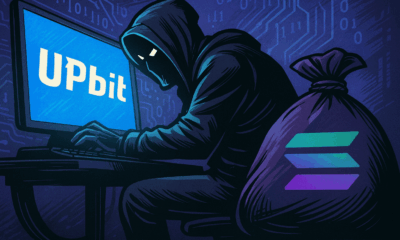Altcoins
October Could Be “ETF Month” — 16 Crypto Funds Face SEC Decision Deadlines

- Share
- Tweet /data/web/virtuals/383272/virtual/www/domains/theunhashed.com/wp-content/plugins/mvp-social-buttons/mvp-social-buttons.php on line 63
https://theunhashed.com/wp-content/uploads/2025/09/uptober-1000x600.png&description=October Could Be “ETF Month” — 16 Crypto Funds Face SEC Decision Deadlines', 'pinterestShare', 'width=750,height=350'); return false;" title="Pin This Post">
Next month may prove momentous for the crypto world — the U.S. Securities and Exchange Commission (SEC) is slated to issue final determinations on 16 spot crypto exchange-traded fund (ETF) applications throughout October. If approved, these could open up regulated investor access to altcoins like Solana, XRP, Litecoin, and even Dogecoin.
For many in crypto and institutional investing, October is shaping up as a “make-or-break” month. A wave of ETF decisions could shift market sentiment, reshape investment flows, and test whether the SEC is truly moving toward a more crypto-friendly posture.
Let’s unpack what’s at stake, what the deadlines look like, and what the wider implications could be.
The Landscape: 16 Spot Crypto ETFs, Many Altcoins, Key Deadlines
While Bitcoin spot ETFs have already gained traction, the next frontier is altcoin spot ETFs — funds directly tied to non-Bitcoin tokens. In October, the SEC must determine whether to approve or reject 16 such applications.
Some notable tokens in the mix include Solana (SOL), XRP, Litecoin (LTC), and Dogecoin (DOGE). The applications have staggered final decision dates throughout the month.
The earliest deadline is October 2, when the SEC must decide on the Canary Litecoin ETF. October 10 brings decisions on the proposed conversions of Grayscale’s Solana and Litecoin products. The last major deadline currently on the docket is October 24, when the SEC must decide on WisdomTree’s XRP ETF.
Importantly, the SEC retains the discretion to act at any time before each deadline rather than waiting until the final date.
ETF analysts and market watchers are treating this stretch as a critical juncture. Nate Geraci, president of NovaDius Wealth Management, described the upcoming weeks as “enormous” for spot crypto ETFs. Another trader dubbed October simply “ETF month,” emphasizing the sheer density of decisions expected.
Notably absent from this particular round are Fidelity and BlackRock, two of the largest and most influential asset managers. Their absence suggests that even if the SEC approves this first wave of altcoin ETFs, the biggest players in traditional finance may still be watching from the sidelines before making their move.
Why This Matters: Market Impact, Institutional Access, Regulatory Tone
If approved, these spot altcoin ETFs would allow investors — especially institutions constrained by strict regulatory regimes — to gain exposure to tokens like SOL, XRP, LTC, and DOGE via regulated financial products. This could significantly reduce risks associated with directly holding digital assets, such as exchange failure, hacking, or custody issues.
The mere expectation of ETF approvals has historically boosted market sentiment. This October could ignite an “altcoin season,” where investor optimism and fresh inflows bring renewed attention to assets outside of Bitcoin and Ethereum. Some analysts believe this wave of regulated investment vehicles might trigger a new leg of growth for the broader crypto market.
The decisions also serve as a litmus test for the SEC’s evolving regulatory posture. In recent months, the agency has made subtle shifts, including approving a new listing standard for commodity-based trust shares, which could streamline future crypto ETF approvals. While this doesn’t guarantee success for these altcoin proposals, it does mark a potentially more open stance than in previous years.
Furthermore, this October round represents a competitive opportunity for smaller or more crypto-native asset managers. Without BlackRock or Fidelity in the mix just yet, lesser-known firms have a chance to gain first-mover advantage and define how altcoin ETFs are structured and marketed. Success this round might well prompt the institutional giants to file their own proposals in subsequent quarters.
Risks, Uncertainties, and Variables to Watch
The SEC can act at any point — not necessarily on deadline days — meaning approvals or rejections could come without warning. The timing will be unpredictable, and that unpredictability could fuel significant market volatility.
Each token tied to an ETF has its own unique regulatory profile. XRP, for instance, recently emerged from a years-long legal battle with the SEC over whether it should be classified as a security. Other tokens, like Solana or Dogecoin, face their own questions around decentralization, developer control, and exchange listing history. These factors will likely influence the SEC’s decision-making process on a case-by-case basis.
Even if the SEC grants approval, the actual rollout of these ETFs will depend on complex logistical factors. Custody solutions, auditing standards, market-making, and exchange infrastructure all need to align before trading can begin.
The broader macro environment also plays a role. Rising interest rates, evolving regulatory scrutiny, or a general market downturn could slow enthusiasm for these new products. And of course, the SEC could still reject many or all of the applications, maintaining a more conservative regulatory stance.
What to Monitor in October
The crypto community will be watching closely for which ETFs receive approval or rejection — and for which tokens. Observers are also keen to see whether decisions come early or at the last minute, and what reasoning the SEC provides in its public statements.
The responses of the ETF issuers themselves will also be revealing. If approved, how quickly will they move to launch? How will they structure the products, and how will they communicate with potential investors?
Market reactions will provide further insight. Will we see a spike in altcoin prices? Increased trading volumes? Renewed interest from institutional desks?
Outlook: Is October a Turning Point?
October holds real potential to reshape how altcoins are viewed in the institutional landscape. If the SEC greenlights even a few of these spot altcoin ETFs, it will send a strong message that regulated exposure to non-Bitcoin crypto assets is not only viable but now welcome.
That shift could fundamentally change how institutions approach the asset class — unlocking new flows of capital, boosting legitimacy, and fueling the next phase of crypto integration into the broader financial system.
Still, the road remains uncertain. Technical, legal, and political headwinds persist. But for now, all eyes are on October — the month that could redefine the future of crypto ETFs in America.
Altcoins
Meme Coins Are Losing Their Mojo — From 20 % of Crypto Buzz to Just 2.5 % This Year

Meme‑Coin Hype Takes a Hard Hit
A recent report shows that collective interest in meme coins has plunged from about 20 % of all crypto chatter in late 2024 to roughly 2.5 % by October 2025 — a collapse of nearly 90 %. This shift reflects not only a drop in social buzz but also a broader retreat of speculative enthusiasm across the market. What once felt like the wild west of crypto — rapid launches, viral marketing and huge price swings — is cooling fast.
Market Metrics Confirm the Slide
The decline isn’t just anecdotal. Over the past year, more than 13 million meme tokens flooded the market, many with little to no utility — and most quickly vanished or failed. In a sector built on hype, many of these coins turned out to be short‑lived bets. Overall, the fully diluted market capitalization of memes has dropped by nearly 50 % year‑to‑date, according to blockchain analytics firms.
Trading volume has also cratered. In the first quarter of 2025, memecoin trading volume reportedly fell by 63 %. In many markets, memecoins’ share of overall trading volume dropped below 4 %, marking a dramatic retreat from their previous prominence.
What’s Driving the Decline
The collapse appears driven by a mix of oversaturation, weak fundamentals, and shifting investor preference. The meme‑coin ecosystem became overcrowded — tens of millions of projects launched, many with no clear roadmap or utility beyond chasing quick returns. That oversupply, combined with a broader crypto market slump, has wreaked havoc on liquidity and investor confidence.
Some analysts also cite growing regulatory scrutiny and a rising demand for real utility and transparency rather than hype‑driven “get‑rich‑quick” schemes. Meanwhile, capital and attention are rotating toward more tangible crypto sectors — such as AI‑powered tokens, infrastructure projects, DeFi, privacy coins and even traditional‑finance–style crypto instruments.
Could This Be a “Generational Bottom”?
Some within the community argue that the crash may bottom out soon — and that a new cycle could follow. Once the “dead weight” of unsustainable projects is cleared out, more serious, utility‑driven tokens could regain attention. Others believe the meme‑coin era may be effectively over — that the speculative mania has dissipated, and unless a meme coin brings real innovation or value, investors will avoid it.
Broader Implications for Crypto Markets
The downfall of meme coins underscores a broader maturation of the crypto industry in 2025. Markets appear to be shedding excess speculation and gravitating toward assets with fundamentals. This could lead to healthier ecosystem growth, better token design, and more sustainable long‑term investment — but also less room for high‑risk, high‑reward “moonshot” plays that defined crypto’s early years.
Altcoins
NYSE Arca Files to Launch Altcoin-Focused ETF

Fresh Rule‑Change Proposal Seeks Green Light From SEC
A fresh proposal filed by NYSE Arca could soon bring a new kind of cryptocurrency investment product to the U.S. market. In partnership with asset management giant T. Rowe Price, the exchange is seeking regulatory approval to list an actively managed crypto ETF that goes beyond Bitcoin and Ethereum. If approved, the fund would give investors exposure to a mix of top altcoins—like Solana, XRP, Cardano, and more—through a traditional stock exchange, eliminating the need for wallets, private keys, or crypto trading accounts.
What the Fund Would Do: A Broad, Actively‑Managed Crypto Basket
The Fund isn’t a passive single‑asset product but aims for active management. Its objective is to outperform the FTSE Crypto US Listed Index over the long term.
At launch the Fund intends to hold a diversified basket of “Eligible Assets,” which currently include major tokens such as Bitcoin (BTC), Ether (ETH), Solana (SOL), XRP, Cardano (ADA), Avalanche (AVAX), Litecoin (LTC), Polkadot (DOT), Dogecoin (DOGE), Hedera (HBAR), Bitcoin Cash (BCH), Chainlink (LINK), Stellar (XLM), and Shiba Inu (SHIB).
The Fund may hold as few as five, or as many as fifteen, crypto assets at any given time — and is not strictly tied to the index’s weighting. It may over‑ or underweight certain assets, or include crypto outside the index, guided by active selection criteria such as valuations, momentum and fundamental factors.
The idea is to give investors exposure to a diversified crypto portfolio without having to manage wallets, custody, and rebalancing — while potentially delivering better returns than a static, index‑tracking fund.
Risk Controls, Custody and Governance
To ensure safety and regulatory compliance, the Fund will store its crypto holdings with a dedicated crypto custodian. Private keys will be secured under strict controls, preventing unauthorized access or misuse.
When the Fund stakes any crypto (if staking is employed), it will maintain policies to ensure sufficient liquidity to meet redemptions, especially if a large portion of assets becomes illiquid or locked.
Valuation of the crypto holdings — used to compute Net Asset Value (NAV) per share — will rely on reference rates from third‑party price providers, aggregated across multiple platforms. The NAV will be computed daily, aligned with close of trading on the Exchange or 4:00 p.m. E.T.
Why It Matters for Crypto and Traditional Finance
This filing reflects a broader shift in traditional financial markets embracing diversified, regulated crypto investment vehicles. Unlike earlier spot‑crypto ETFs designed for single assets (e.g., Bitcoin), this Fund proposes a multi‑asset, actively managed basket — potentially appealing to institutional investors and diversified‑portfolio allocators seeking crypto exposure with traditional ETF convenience.
If approved, the Fund would offer a streamlined, compliance‑friendly bridge between traditional capital markets and crypto assets, lowering operational friction for investors who prefer not to deal with wallets, exchanges, or self‑custody.
The approach may also set a precedent: showing that active crypto ETFs can meet listing standards under rules originally written for commodity‑based trusts. This could open the door for more innovation — perhaps funds targeting niche themes (smart‑contract tokens, layer‑2s, tokenized real‑assets) while still abiding by exchange and regulatory requirements.
What’s Next
The SEC review period typically spans up to 45 days from publication (or longer if extended), during which comments from market participants and the public may shape the final decision.
If approved, it may take some additional time before shares begin trading — during which documents like the fund’s prospectus, ETF symbol, and listing date will be finalized and disclosed by the sponsor.
Altcoins
Securitize Breaks New Ground: EU Greenlights Blockchain-Based Securities Exchange on Avalanche

In a major development for the future of digital finance, Securitize has secured approval from European regulators to launch a fully regulated tokenized trading and settlement system using blockchain infrastructure. The move positions Securitize as the first entity authorized to run a DLT-powered securities exchange under the European Union’s Distributed Ledger Technology (DLT) Pilot Regime—and it’s choosing Avalanche to power its operations.
From Fintech Middleman to Full-Fledged Market Operator
Until now, Securitize has been best known as a digital asset enabler, acting as a transfer agent and broker-dealer for tokenized securities, particularly in the U.S. market. But with this new license, granted by Spain’s Comisión Nacional del Mercado de Valores (CNMV), the company is evolving into a full-blown market infrastructure provider across all 27 EU member states.
This transformation is not symbolic. Securitize now holds the right to issue, trade, and settle tokenized financial instruments—from equities and bonds to funds and structured products—all on-chain. And crucially, this will be done within a regulated framework, providing the safeguards that institutions require.
Avalanche Selected for Institutional-Grade Performance
To make this vision real, Securitize has chosen Avalanche as the underlying blockchain. The rationale is technical and strategic: Avalanche’s architecture offers near-instant finality, high throughput, and customizable subnets, features that align with the compliance and performance demands of capital markets.
The use of Avalanche isn’t merely cosmetic—it reflects a fundamental shift in how market infrastructure can be built. Instead of retrofitting blockchains into legacy systems, Securitize is designing the platform from the ground up with blockchain-native capabilities, but under regulatory scrutiny. This ensures that investor protections, KYC/AML procedures, and auditability are baked into the system rather than added on.
Tokenization Enters Its Institutional Era
Tokenization is hardly a new concept, but regulatory inertia and infrastructure gaps have kept it on the sidelines. Securitize’s new status could change that. By integrating issuance, trading, and settlement into a single digital framework, it offers institutional players a practical, legally compliant path into tokenized finance.
Real-world assets (RWAs) like corporate bonds, private equity, and even real estate can now be fractionalized and traded in near real-time. The efficiency gains—from lower settlement risk to reduced administrative overhead—are potentially game-changing. But what makes this moment different is not just the tech; it’s the regulatory blessing that now accompanies it.
The pilot regime allows Securitize to experiment in a live environment without skirting the rules. It’s a sandbox with teeth: serious enough for institutional engagement, yet flexible enough to innovate.
A Cross-Atlantic Infrastructure with Global Ambitions
Securitize’s European expansion doesn’t exist in isolation. The firm is already active in the United States, having facilitated tokenized offerings under SEC-compliant structures. The ability to bridge compliant infrastructure across the Atlantic is no small feat. If successful, it could lay the foundation for the first global, interoperable system for tokenized securities.
That ambition is bolstered by the firm’s all-in-one platform approach. Unlike many blockchain ventures that require third-party coordination for issuance, custody, trading, and compliance, Securitize offers a vertically integrated stack. This could prove especially attractive for asset managers looking to tokenize their offerings without building custom infrastructure from scratch.
The Road Ahead: High Stakes and Real Timelines
According to internal timelines, the first tokenized instruments on this new European platform are expected to launch in early 2026. That gives Securitize just over a year to finalize the technical, legal, and operational frameworks needed to go live.
But success will hinge on more than deadlines. To achieve real impact, Securitize must:
- Convince major asset issuers—such as private equity firms, debt fund managers, and banks—to tokenize through its platform.
- Deliver enough liquidity to make the exchange viable for secondary trading.
- Prove that blockchain-based settlement is not just faster, but materially better in terms of cost, transparency, and security.
The broader market will be watching closely. Traditional exchanges, DeFi protocols, and regulators alike will be scrutinizing this launch as a bellwether for the viability of tokenized financial markets.
Conclusion: A Quiet Revolution in Plain Sight
With regulatory backing and a serious technological partner in Avalanche, Securitize has entered a rarefied position: not merely talking about the future of finance, but building it. If the rollout meets expectations, 2026 could mark a turning point—where securities trading takes a decisive step away from analog rails and embraces the digital, programmable, and borderless possibilities of blockchain.
In the ever-theoretical world of tokenization, Securitize now has a chance to make it real.
-

 Cardano2 months ago
Cardano2 months agoCardano Breaks Ground in India: Trivolve Tech Launches Blockchain Forensic System on Mainnet
-

 Cardano2 months ago
Cardano2 months agoCardano Reboots: What the Foundation’s New Roadmap Means for the Blockchain Race
-

 Cardano2 days ago
Cardano2 days agoSolana co‑founder publicly backs Cardano — signaling rare cross‑chain respect after 2025 chain‑split recovery
-

 Bitcoin2 months ago
Bitcoin2 months agoQuantum Timebomb: Is Bitcoin’s Foundation About to Crack?
-

 Cardano2 months ago
Cardano2 months agoAfter the Smoke Clears: Cardano, Vouchers, and the Vindication of Charles Hoskinson
-

 Cardano2 months ago
Cardano2 months agoMidnight and Google Cloud Join Forces to Power Privacy‑First Blockchain Infrastructure
-

 Ripple2 months ago
Ripple2 months agoRipple CTO David “JoelKatz” Schwartz to Step Down by Year’s End, but Will Remain on Board
-

 News2 months ago
News2 months agoRipple’s DeFi Awakening: How mXRP Is Redefining the Role of XRP









